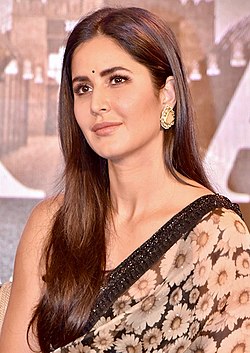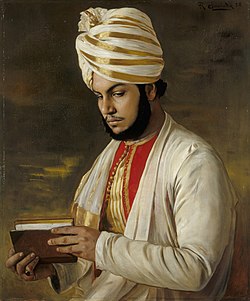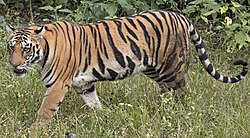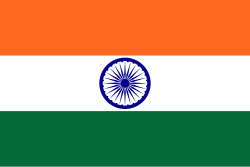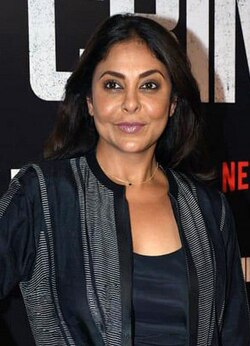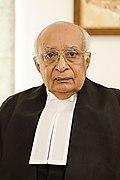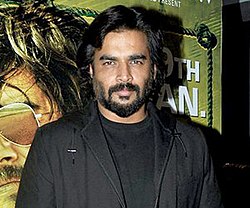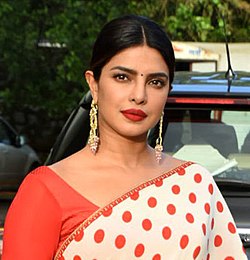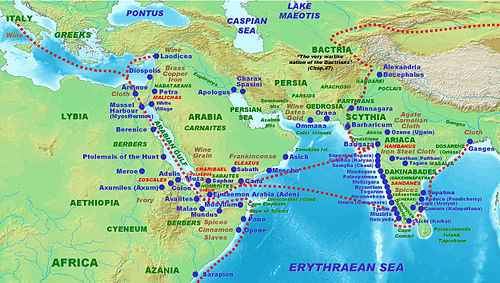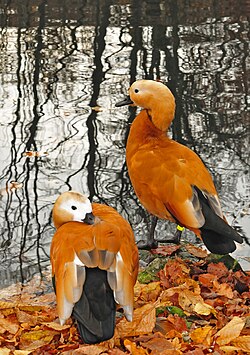Portal:India
Introduction


India, officially the Republic of India, is a country in South Asia. It is the seventh-largest country by area; the most populous country from June 2023 onwards; and since its independence in 1947, the world's most populous democracy. Bounded by the Indian Ocean on the south, the Arabian Sea on the southwest, and the Bay of Bengal on the southeast, it shares land borders with Pakistan to the west; China, Nepal, and Bhutan to the north; and Bangladesh and Myanmar to the east. In the Indian Ocean, India is near Sri Lanka and the Maldives; its Andaman and Nicobar Islands share a maritime border with Thailand, Myanmar, and Indonesia. (Full article...)
Selected pictures
Devdas is a 2002 Indian Hindi-language epic romantic drama film directed by Sanjay Leela Bhansali. It stars Shah Rukh Khan, Aishwarya Rai and Madhuri Dixit, while Kirron Kher, Smita Jaykar and Vijayendra Ghatge play supporting roles. The film's story focuses on Devdas (Khan), a Bachelor of Law student who later becomes an alcoholic after his family rejects his relationship with Paro (Rai Bachchan), Devdas' childhood friend. The film was produced by Bharat Shah for his company Mega Bollywood, and its screenplay was written by Bhansali and Prakash Ranjit Kapadia, who also wrote the dialogue. The soundtrack for Devdas was composed by Ismail Darbar and Birju Maharaj, who co-wrote the lyrics with Nusrat Badr and Sameer Anjaan. Binod Pradhan and Bela Sehgal completed the cinematography and editing, respectively, while Nitin Chandrakant Desai handled the production design.
Made on a budget of ₹500 million (US$5.8 million), Devdas premiered at the 2002 Cannes Film Festival on 23 May 2002 and was released worldwide on 12 July that year. It received mixed reviews from critics, but emerged as the highest-grossing Indian film of the year, earning ₹998.8 million (US$12 million). The film won 61 awards from 91 nominations; its direction, music, performances of the cast members, screenplay, cinematography, choreography, costumes and production design have received the most attention from award groups. (Full article...)

Kangana Ranaut is an Indian actress and filmmaker who predominantly works in Hindi films, in addition to a few Tamil films. She has received four National Film Awards, five Filmfare Awards, three International Indian Film Academy Awards, and one award each from the Screen, Zee Cine, SIIMA, and Producers Guild award ceremonies.
Ranaut made her acting debut in 2006 with a leading role in the romantic thriller Gangster, winning the Filmfare Award for Best Female Debut. Her portrayals of a character based on actress Parveen Babi in Woh Lamhe (2006) and a shrewd socialite in Life in a... Metro (2007) were lauded, with the latter earning her a Stardust Award for Breakthrough Performance – Female. She won the National Film Award for Best Supporting Actress and a Filmfare Award in the same category for playing a substance abusing supermodel in the drama Fashion (2008). Also in 2008, she featured in the Tamil film Dhaam Dhoom. (Full article...)
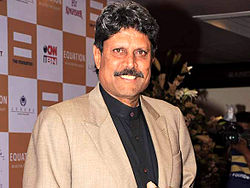
Kapil Dev is a former Test and One Day International (ODI) cricketer who represented India between 1978 and 1994. He took 24 five-wicket hauls during his international career. In cricket, a five-wicket haul—also known as a five-for or fifer—refers to a bowler taking five or more wickets in a single innings. This is regarded as a notable achievement, and as of October 2024[update], only 54 bowlers have taken 15 or more five-wicket hauls at international level in their cricketing careers. A right-arm fast bowler, Kapil Dev took 434 wickets in Test cricket and 253 in ODIs. With 23 five-wicket hauls in Tests, he has the third highest number of international five-wicket hauls among Indian cricketers as of 2012, after Anil Kumble and Harbhajan Singh. Kapil Dev was named by the Wisden as one of their Cricketers of the Year in 1983 and Indian Cricketer of the Century in 2002. Eight years later, the International Cricket Council (ICC) inducted him into the ICC Cricket Hall of Fame. As of 2012, Kapil Dev also holds the record for being the only player to have taken more than 400 wickets and scored over 5,000 runs in Tests.
Kapil Dev made his Test and ODI debuts against Pakistan, both in 1978. His first five-wicket haul came a year later against England during the first Test of India's tour. His career-best bowling figures in an innings of nine for 83 was achieved in 1983 against the West Indies in Ahmedabad. In Tests, Kapil Dev was most successful against Pakistan and Australia, with seven five-wicket hauls against each of them. He took his only five-wicket haul in ODIs against Australia during the 1983 Cricket World Cup. (Full article...)
The first triple century in the Ranji Trophy was scored by Maharashtra's Vijay Hazare against Baroda in the 1939–40 season. As of November January 2023[update], the most recent triple century in the tournament was scored by Prithvi Shaw from Mumbai, who made 379 against Assam in the 2022–23 season. The highest score in the competition was made by B. B. Nimbalkar, who scored 443 runs not out for Maharashtra against Kathiawar in the 1948–49 season. It is the only instance of a quadruple century in the tournament. The highest number of triple centuries are scored by Ravindra Jadeja, who has reached the milestone three times while playing for Saurashtra. Jadeja is followed by V. V. S. Laxman, Cheteshwar Pujara, and Wasim Jaffer, with two triple centuries each. Tamil Nadu's Woorkeri Raman and Arjan Kripal Singh are the only two batsmen to score triple centuries in the same innings. As of December 2016[update], five batsmen have scored 290–299 runs in an innings, and three of them were not out. (Full article...)

A One Day International (ODI) is an international cricket match between two teams, each having ODI status, as determined by the International Cricket Council. The women's variant of the game is similar to the men's version, with minor modifications to umpiring and pitch requirements. The first women's ODI was played in 1973, between England and Australia. The Indian women's team played their first ever ODI match in 1978, against England, after the Women's Cricket Association of India was formed. The Women's Cricket Association of India was merged with the Board of Control for Cricket in India in 2006 as part of the International Cricket Council's initiative to develop women's cricket.
Since the team was formed, 151 women have represented India in ODI cricket. This list includes all players who have played at least one ODI match and is arranged in the order of debut appearance. Where more than one player won their first cap in the same match, those players are listed alphabetically by last name at the time of debut. (Full article...)
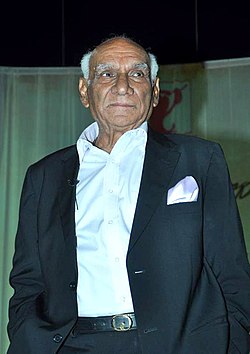
Yash Raj Films (abbreviated as YRF) is an Indian entertainment company, established by filmmaker Yash Chopra in 1970, that produces and distributes motion pictures. As of 2022, the company has produced over 80 Hindi films and one Tamil film. YRF started a film distribution business in 1997; in addition to distributing their own productions, the company has handled the domestic and/or international distribution of over 50 films from other companies. The most frequent collaborations of the company have been with the actors Rani Mukerji, Rishi Kapoor, Shah Rukh Khan, Anushka Sharma, Katrina Kaif, and Saif Ali Khan.
YRF's first release came in 1973 with the Chopra-directed Daag, a drama about bigamy, starring Rajesh Khanna, Raakhee and Sharmila Tagore. The company had four more releases in the 1970s, including the ensemble romantic drama Kabhi Kabhie and the action film Kaala Patthar, both of which starred Amitabh Bachchan and Raakhee. YRF's sole commercial success in the 1980s was the Sridevi-starring romantic musical Chandni. The year 1995 marked the directorial debut of Chopra's elder son Aditya Chopra with the highly successful romantic drama Dilwale Dulhania Le Jayenge. Starring Shahrukh Khan and Kajol, the film has the longest theatrical run in Indian cinema history. Other successful releases of the 1990s were Darr (1993) and Dil To Pagal Hai (1997), both starring Khan. (Full article...)

Vijay is an Indian actor, playback singer and politician who works in Tamil cinema. He made his cinematic debut in 1984 with Vetri, directed by his father, S. A. Chandrasekhar. After appearing in Chandrasekhar's films as a child artist, Vijay made his debut as a lead actor with Naalaiya Theerpu (1992) at the age of 18. He followed it with a role opposite Vijayakanth in Senthoorapandi (1993). Vijay went on to play lead roles in his father's directorial ventures such as Rasigan (1994) and Deva (1995) and Vishnu (1995). Most of those films were successful commercially.
Vijay's first commercial blockbuster was romcom Coimbatore Mappillai in 1996, followed by his breakthrough blockbuster romance film, Poove Unakkaga. His subsequent films, Love Today (1997) and Kadhalukku Mariyadhai (1997), were critically and commercially successful. His performance in the latter won him the Tamil Nadu State Film Award for Best Actor. Thullatha Manamum Thullum (1999), where he played a passionate singer gained him the reputation of a romantic hero. (Full article...)
Preity Zinta is an Indian actress, who has received several awards for her acting in Hindi films. Her career began in 1998 with Mani Ratnam's acclaimed drama Dil Se.. and the box office hit Soldier. Both films won her the award for Best Female Debut at the 44th Filmfare Awards. Her performance in Dil Se.. also earned her a Best Supporting Actress nomination at the same ceremony, while Soldier won her three more Best Debut awards at other major ceremonies. Zinta received her first Filmfare nomination for Best Actress for her portrayal of a teenage single mother in Kya Kehna. She followed these films with several critically and commercially successful films, such as Mission Kashmir (2000) and Dil Chahta Hai (2001), and her performances in Chori Chori Chupke Chupke (2001), Dil Hai Tumhaara (2002) and Armaan (2003) were praised.
Zinta won several awards for her performance in the romantic comedy-drama Kal Ho Naa Ho, including her first and only Filmfare Award for Best Actress. She went on to star in top-grossing productions in India and abroad, including Koi... Mil Gaya (2003), Veer-Zaara (2004), Salaam Namaste (2005) and Kabhi Alvida Naa Kehna (2006), all of which earned her different nominations at major award ceremonies, which, in addition to Filmfare, include such organisations as Screen, Zee Cine, the International Indian Film Academy (IIFA), and Stardust, among others. After a relatively low phase, she started appearing in arthouse films, known in India as parallel cinema. She played her first international film role in Deepa Mehta's Canadian drama Heaven on Earth (2008, titled Videsh in India). Her portrayal in the film won her the Silver Hugo Award for Best Actress at the Chicago International Film Festival, and she was a Best Actress nominee at several award functions in Canada, including the Genie Awards by the Academy of Canadian Cinema & Television, and the Vancouver Film Critics Circle. (Full article...)

Sachin Tendulkar played for India, widely acknowledged as one of the greatest batsmen of all time, he is the most prolific run-scorer in international cricket. Tendulkar has scored the highest number of centuries (100 or more runs) in Test matches and One Day International (ODI) matches organised by the International Cricket Council. His total of 51 centuries in Test matches is a world record for highest number of centuries by a batsman and his 49 centuries in ODI matches are the second highest number of centuries after Virat Kohli. He became the first and only cricketer to score 100 international centuries when he made 114 against Bangladesh in March 2012.
After making his Test debut in 1989, Tendulkar achieved his first century against England at Old Trafford, Manchester in 1990; he made 119 not out. In Test matches, Tendulkar has scored centuries against all the Test cricket playing nations, and is the second batsman to score 150 against each of them. He has scored a century in at least one cricket ground of all Test cricket playing nations, except Zimbabwe. In October 2010, Tendulkar went past Brian Lara's record of 19 scores of 150 or more by hitting his 20th against Australia in Bangalore. He made his highest score in 2004, when he made 248 not out against Bangladesh at the Bangabandhu National Stadium, Dhaka. Tendulkar has scored six double centuries and remained unbeaten on 15 occasions. His centuries have come in 30 different cricket grounds, with 27 of them being scored in venues outside India. Tendulkar has been dismissed nine times between scores of 90 and 99. (Full article...)
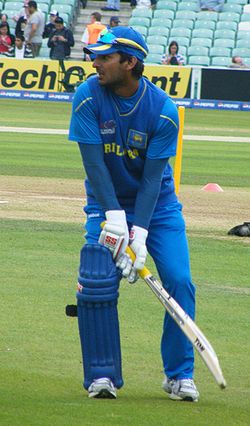
The Hyderabad Deccan Chargers (often abbreviated as DC) was a franchise cricket team based in Hyderabad, Telangana, that competed in the Indian Premier League (IPL) from 2008 to 2012. The team was owned by Deccan Chronicle Holdings Limited who won the bid for the Hyderabad franchise at US$107 million. VVS Laxman and Robin Singh were appointed as the captain and the coach for their first season in 2008. After finishing last in that season, the DC sacked their coach and removed their captain and replaced them with Darren Lehmann and Adam Gilchrist under whom they won their only IPL title in 2009, when they defeated the Royal Challengers Bangalore by six runs in the final. They reached the semi-finals again in 2010 but failed to reach past the group stages before the team was folded in 2012. They qualified for the Champions League Twenty20 only once, for the 2009 season, but failed to advance past the group stage. Lehmann remained as the coach for the DC but they were forced to replace Gilchrist with Kumar Sangakkara in 2011 after they lost former to the Kings XI Punjab in the 2011 auction. Sangakkara remained as the captain until the middle of the 2012 season before he was replaced by Cameron White following the poor performances. Sangakkara later returned as captain as the move did not yield the desired results for the Deccan Chargers.
On 15 September 2012, the Deccan Chargers' IPL contract was terminated by the Board of Control for Cricket in India (BCCI), which was concerned about overdue payments to the players. The Hyderabad franchise was later acquired by the Sun TV Network for ₹85.05 crore (US$9.9 million) per year in a bid which also retained 20 players. (Full article...)

The chief minister of West Bengal (IAST: Paścim Baṅgēr Mukhya Mantrī) is the de facto head of the executive branch of the Government of West Bengal, the subnational authority of the Indian state of West Bengal. The chief minister is head of the Council of Ministers and appoints ministers. The chief minister, along with their cabinet, exercises executive authority in the state. The governor appoints the chief minister, whose council of ministers are collectively responsible to the assembly.
On 17 August 1947, the British Indian province of Bengal was partitioned into the Pakistani province of East Bengal and the Indian state of West Bengal. Since then West Bengal has had seven chief ministers, starting with Prafulla Chandra Ghosh of the Indian National Congress (INC) party as the premier (elected to lead the assembly while the chief minister is not appointed). Dr. Bidhan Chandra Roy in 1950 became the first formal chief minister of West Bengal after the implementation of the Indian Constitution. A period of political instability followed thereafter—West Bengal witnessed three elections, four coalition governments and three stints of President's rule between 1967 and 1972—before Siddhartha Shankar Ray of the INC served a five-year term. (Full article...)
News
- 29 April 2025 – Kashmir conflict
- 2025 India–Pakistan border skirmishes
- Pakistani Information Minister Attaullah Tarar says that India intends to launch a military strike on Pakistan within the next 24 to 36 hours. (Reuters)
- 28 April 2025 – Kashmir conflict
- 2025 India–Pakistan border skirmishes
- Pakistani Defence Minister Khawaja Asif says that a military incursion by India is imminent. (Reuters)
- 26 April 2025 – 2025 India–Pakistan diplomatic crisis
- Severe flooding is reported along the Jhelum River in Pakistan-administered Azad Kashmir after Indian authorities release a large amount of water without prior warning. The incident follows the suspension of the Indus Waters Treaty by the Indian government. (24 News HD)
Did you know...
- ... that the first Indian-American mayor of Fremont, California, succeeded its first female and first Asian-American mayor?
- ... that of the 146 Conestoga wagons employed by the Braddock Expedition in the French and Indian War, only one remained intact by the campaign's end?
- ... that when visiting Britain during World War II, naval officer Kalyani Sen reported that Indian women were breaking down prejudices against men and women working together by joining the military?
- ... that in the 1932 baseball game in which pitcher Eddie Rommel won his last game, he pitched 17 innings in relief, an American League record?
- ... that 24-year-old Mahasweta Chakraborty of Operation Ganga helped around 800 students return to India during the Russian invasion of Ukraine?
- ... that Grandpa Indian, created in the 1930s to replace Santa Claus in Brazil, was portrayed as adorned in colorful bird feathers, bringing gifts to Brazilian children?
Topics related to India
Timeline of Indian history, Indus Valley Civilisation, Dholavira, Science and technology in ancient India, Meluhha, Aryan invasion theory, Out of India theory, Greek conquests in India, Indian maritime history, Maurya Empire, Ashoka, Shunga Empire, Hoysala Empire, Vijayanagara, Satavahana dynasty, Indo-Greek Kingdom, Indo-Scythians, Indo-Parthian Kingdom, Kushan Empire, Western Satraps, Gupta Empire, Chola dynasty, Pala Empire, Islamic incursions in India, Mughal Empire, Maratha Empire, British Raj, East India Company, Governor-General, Viceroy, War of Independence, 1857, Indian independence movement, Indian National Army, Azad Hind, Quit India Movement, Partition of India, History of Republic of India, Non-Aligned Movement, Sino-Indian War, Indo-Pakistani War of 1947–1948, Indo-Pakistani War of 1965, Indo-Pakistani War of 1971, Kargil War, 2001–02 India–Pakistan standoff, Military, Demographic
Law, Hindu law, Constitution, Political parties (Indian National Congress, Bharatiya Janata Party), Foreign relations, Elections, Political divisions, Reservation in India
Government agencies, Legislative branch (Lok Sabha, Rajya Sabha) Executive branch (President & Vice President, Prime Minister & Deputy Prime Minister, Cabinet Ministers, Cabinet Secretary, Election Commission, Foreign Minister; Law enforcement: CBI, CID, Intelligence: IB, RAW), Directorate General of Income Tax Investigation Judicial branch (Supreme Court), Armed Forces (Army, Navy, Air Force, Border Security Force, Coast Guard)
Himalayas, Western Ghats, Eastern Ghats, Indo-Gangetic Plain, Deccan Plateau, Thar Desert, Ganges, Rann of Kutch, Brahmaputra River, Northeast India; Mountains, Valleys, Islands, Rivers; States and union territories, Cities, Districts, Regions, Fauna, Flora
Rupee, Bombay Stock Exchange, National Stock Exchange, Standard of living, Companies, Reserve Bank of India, Energy policy (Solar, Wind, Nuclear), Tourism, Transport (Expressways, Rail transport, Auto rickshaw),
Languages, Standard of living, Religion
Music (Carnatic, Hindustani, Indi-pop), Dance, Languages, Literature, Architecture, Film & TV, Cuisine, Holidays, Folklore, Education, Media, Indian martial arts
Indian Council of Agricultural Research (ICAR), Indian Institute of Astrophysics, National Centre for Software Technology, AIIMS, IISc, IIT, NIT, BITS-Pilani, INRegistry, Indian numbering system, Indian Space Research Organisation, National Internet Exchange of India, ICRISAT, International Institute of Information Technology, Hyderabad
Indian English, Indian nationality law, Numbering system, Indian Space Research Organisation, Telecommunications, National Highways Development Project, Flag, Vehicle registration plates, Indian nationalism, Metrication in India
Categories
Related portals
Religions in India
Indian Subcontinent
Other countries
Wikipedias in Indian languages
- অসমীয়া (Assamese)
- বাংলা (Bengali)
- भोजपुरी (Bhojpuri)
- বিষ্ণুপ্রিয়া মণিপুরী (Bishnupriya Manipuri)
- गोंयची कोंकणी / Gõychi Konknni (Konkani)
- ગુજરાતી (Gujarati)
- हिन्दी (Hindi)
- ಕನ್ನಡ (Kannada)
- कॉशुर/كشميري (Kashmiri)
- मैथिली (Maithili)
- മലയാളം (Malayalam)
- मराठी (Marathi)
- नेपाली (Nepali)
- नेपाल भाषा
- (Newari)
- ଓଡ଼ିଆ (Odiya)
- ਪੰਜਾਬੀ (Punjabi)
- पालि (Pali)
- संस्कृत (Sanskrit)
- ᱥᱟᱱᱛᱟᱲᱤ (Santali)
- سنڌي (Sindhi)
- தமிழ் (Tamil)
- తెలుగు (Telugu)
- ತುಳು (Tulu)
- اردو (Urdu)
Associated Wikimedia
The following Wikimedia Foundation sister projects provide more on this subject:
-
Commons
Free media repository -
Wikibooks
Free textbooks and manuals -
Wikidata
Free knowledge base -
Wikinews
Free-content news -
Wikiquote
Collection of quotations -
Wikisource
Free-content library -
Wikiversity
Free learning tools -
Wikivoyage
Free travel guide -
Wiktionary
Dictionary and thesaurus


![Image 1 Kaif promoting Bharat in 2019 Katrina Kaif (pronounced [kəˈʈriːna kɛːf]; born Katrina Rosemary Turcotte, 16 July 1983) is a British actress who works in Hindi-language films. One of the highest-paid actresses in India, she has received accolades, including four Screen Awards and four Zee Cine Awards, in addition to three Filmfare nominations. Though reception to her acting has varied, she is noted for her action film roles and her dancing ability. Born in British Hong Kong, Kaif lived in several countries before she moved to London for three years. She received her first modelling assignment as a teenager and later pursued a career as a fashion model. At a fashion show in London, Indian filmmaker Kaizad Gustad cast her in Boom (2003), a critical and commercial failure. While Kaif established a successful modelling career in India, she initially had difficulty finding film roles due to her poor command of Hindi. After appearing in the Telugu film Malliswari (2004), Kaif earned commercial success in Bollywood with the romantic comedies Maine Pyaar Kyun Kiya? (2005) and Namastey London (2007). Further success followed with a series of box-office hits, but she was criticised for her acting, repetitive roles, and inclination to male-dominated films. (Full article...)](http://upload.wikimedia.org/wikipedia/en/d/d2/Blank.png)
